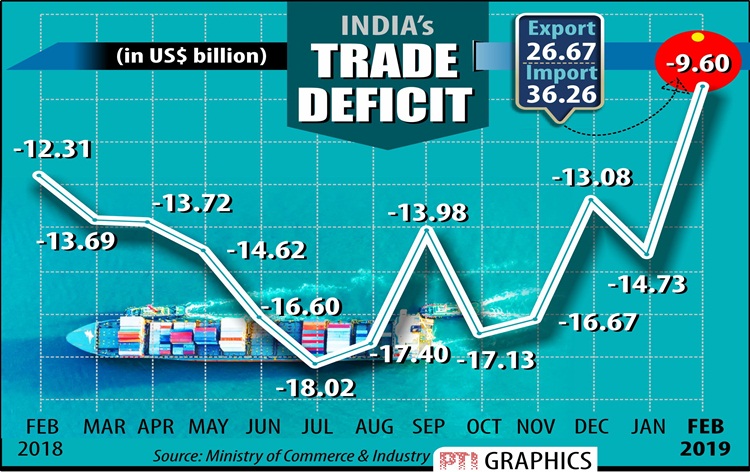Why in news?
India’s trade deficit shrank to a 17-month low in February, 2019 according to the data recently released by the Union ministry of commerce.
What is the trade scenario?
- Trade deficit is the difference between a country's exports and imports.
- India's exports rose 2.44% from a year ago to $26.7 billion and imports contracted by 5.4%.
- This led to a decline in the trade deficit to $9.6 billion.
- The trade deficit was $14.73 billion in January and $12.3 billion in February of the previous year.
- The previous low for the trade gap was $9.4 billion in September 2017.

What are the driving factors?
- The narrowing of the trade deficit is the result of a sharp fall in import of oil, gold and electronics.
- In February, import of oil, gold and electronic items declined by 8%, 10.81% and 6.5%, respectively.
- Notably, these are the items that generally form the bulk of the country’s import bill.
- India’s overall exports (merchandise and services combined) in April-February 2018-19 exhibited a positive growth of 8.73% over the same period last year.
- The major commodity groups of export showing positive growth were organic and inorganic chemicals, drugs and pharmaceuticals, and ready-made textiles.
Does this signal macroeconomic stability?
- Economies across Asia, especially China and Southeast Asian nations, have been showing signs of sluggish growth.
- This is due to the contraction in manufacturing due to slowdown in the global trade and fragile world economy.
- Notably, India's exports rose just 2.4% year on year in February 2019, lower than the 3.7% increase registered in January.
- Crucial sectors such as engineering and gems & jewellery saw low or negative growth. E.g. gems & jewellery exports contracted by 2%
- So the trade deficit has narrowed not because of a robust performance from exports but a relative fall in imports.
- But decrease in imports can hardly be relied upon to keep India’s external account stable.
- Weak exports growth shows that India will continue to struggle to pay for imports if the demand for import items recovers again.
- Moreover, the recent data reveals that India’s structural weaknesses continue too.
- Decline in imports signal the weak industrial demand within the country.
- Given these, the macroeconomic stability cannot be taken for granted with the current narrowing trade deficit.
How does the future look?
- The effect of the global tariff war and the recent rise in crude oil prices due to supply cuts has impacted India’s trade.
- There has been some improvement in terms of permission and ease of doing business over the past few years.
- But these are not enough to ensure competitiveness in export.
- It is not realistic, therefore, to expect a sharp upturn in the short or medium run for Indian exports in these sectors.
- The recently revoked preferential benefits to Indian exports by the US will only make it tougher for certain export sectors to recover.
- This is particularly true of Indian engineering exports, which will have to deal with tighter competition from zero-tariff countries.
Source: Economic Times, Business Standard
